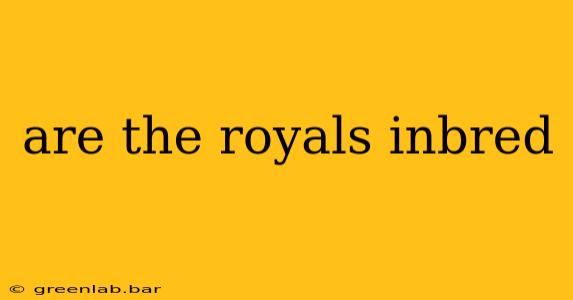Are the Royals Inbred? Exploring the History of Intermarriage in European Royalty
The question of whether royals are inbred is a complex one, steeped in history and fueled by persistent rumors. While the perception of widespread inbreeding among royal families is common, the reality is more nuanced. It's crucial to understand the historical context and the changing societal norms surrounding marriage to accurately assess the extent of inbreeding and its potential consequences.
The Historical Context: Dynastic Marriages and Political Power
For centuries, marriages within royal families were primarily political alliances, designed to consolidate power, maintain territorial integrity, and secure economic advantages. Love and personal preference played a far smaller role than strategic considerations. This practice resulted in a high degree of consanguinity—marriage between individuals sharing a relatively recent common ancestor.
The logic behind these dynastic marriages was simple: marrying within established royal houses ensured that power remained within the family, preventing rival claimants and maintaining stability. This practice, while seemingly self-serving, was considered essential for preserving the realm's stability and safeguarding its interests. The consequences of inbreeding, while understood to some extent, were often considered a secondary concern to the political gains.
The Extent of Inbreeding: Fact Versus Fiction
While it's undeniable that many royal lineages involved a significant degree of intermarriage, the extent of inbreeding and its impact are subjects of ongoing debate amongst historians and geneticists. The very definition of "inbreeding" and the methods used to measure it vary considerably. Moreover, historical records are not always complete or accurate, making definitive statements challenging.
Some historical figures, such as Queen Victoria and her descendants, are frequently cited as examples of the potential negative effects of inbreeding due to the prevalence of hemophilia within the family line. However, even in these instances, the connection is complex, and the role of inbreeding needs to be evaluated alongside other genetic and environmental factors.
Modern Approaches to Royal Marriages
In modern times, the practice of marrying solely within royal families has largely declined. The emphasis has shifted towards choosing spouses based on compatibility and personal preference, although factors such as social standing and suitability still play a role. This transition reflects a broader societal shift away from dynastic marriages and towards a more egalitarian view of relationships.
This move towards more diverse partnerships is not only a reflection of changing social values but also a recognition of the potential risks associated with extensive consanguinity. While the historical legacy of inbreeding remains a fascinating area of study, contemporary royal families are far less likely to engage in practices that could lead to the same level of genetic homogeneity seen in their ancestors.
Conclusion: A Multifaceted Issue
The question of whether royals are inbred requires a detailed understanding of historical context and the changing nature of royal marriages. While historical patterns reveal a significant degree of consanguinity, the extent of its impact and the implications for modern royal families are subject to ongoing research and debate. The shift towards more diverse partnerships signals a departure from past practices and a recognition of the risks associated with close intermarriage. The narrative is more nuanced than a simple "yes" or "no" and demands a deeper dive into the historical and genetic complexities involved.

